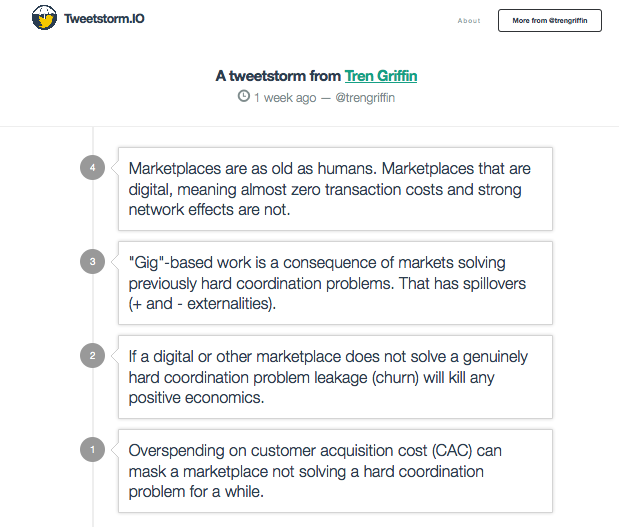Last week Tren Griffin did a tweetstorm on a topic that fascinates me – Marketplaces. Marketplaces are beginning to take over from pure play ecommerce businesses. A marketplace is ultimately a network effect in a form of a platform that provides customers with large selection due to suppliers. Without either part of the equation the marketplace wont gain traction and make any headway.
“Network effects” is a frequently used term and it is sometimes confused with having a large customer base. Network effects is more than just a large number of users – they kick in when the value of a product depends on how many other users there are.
When a new user/member is added to the network, it increases the value of the product or service to all other users. This increased value can be in the form of cost reduction (in user acquisition as an example), higher liquidity (in a marketplace), stronger community or deeper relationships (in social networks), etc. (Versionone.vc)
However marketplaces can also be seen as a solution to an offline inefficiency with technology (mobile). Once the marketplace reaches critical mass the virtuous cycle starts. Uber has now reached that stage and am able to do things that dont necessarily scale – offering loans to drivers etc.
One of the most important things you can do is identify and double down on the things that work in your marketplace. As your marketplace starts scaling, there will be many matches and transactions between buyers and sellers. But not all matches are created equal. Identify where things are really clicking (on both the supply and demand side) – this could be in certain geographies, audience segments, price points, and user behavior. (Versionone.vc)
Over the last 6 months I have been wrestling with Marketplaces, classifieds and comparison shopping engines in terms of model validation. Let me explain – I work for a comparison shopping engine and I have seen first hand how our user base has moved to that medium. In terms of marketplaces – 2 large ecommerce marketplaces merged to form a transformer like business. The marketplace element is deeply hidden and very seldom marketed. In South Africa we have 2 classifieds businesses that are spending plenty and one of them is seen as the largest commerce business in the market. So it is highly possible that a customer can be using all 3 models in a 24 hour time period. I am yet to see any market globally that has these 3 verticals so closely matched in terms of customer perception. (It is normally 2 of the verticals that lead in the customers mind.)
(This tweetstorm can be seen here: Tweetstorm.io)
With the above in mind lets look at the fundamentals of these models:
[table id=1 /]
I am yet to completely be convinced which is a better model for emerging markets. All 3 of them have significant weaknesses and also strengths. Marketplaces is the most costly and thus in need of plenty of investment (one simply needs to look at Flipkarts billions to understand that). Comparison Shopping is very dependent on scale and Classifieds are very dependent on locations and ads being posted by users.
Uber has been able to scale quickly in South Africa due to the fact that public transport is a nightmare. Also it provides a lot of employment that is a problem for many. Over the last 3 months they have been able to aggressively announce and execute partnerships with corporates that have large users bases (Health insurance / medical businesses). I am left with a question about the gig economy in Africa – is it sustainable?

